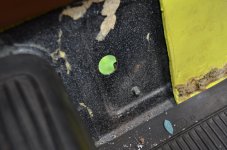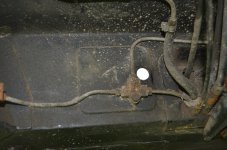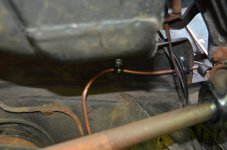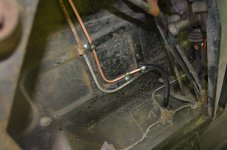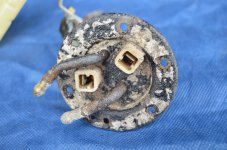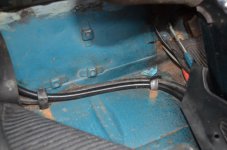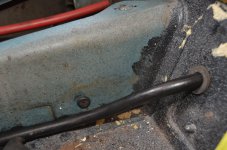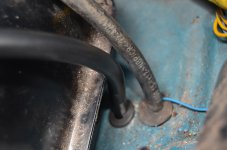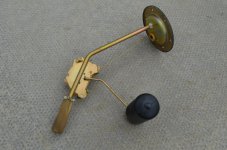I've been installing fuel lines on my 900 van which is designed with a fuel return. As I was equipped with the materials and tools for this job I decided to make yet another modification to my 500.
The carburettor return spigot and the decision over whether to blank it off or route it back to the supply pipe has been discussed and debated a million times here. I have decided to make a full fuel return pipe back to the petrol tank, as fitted on the Fiat 126 and as very well described here:
https://www.flickr.com/photos/ricambifiat500/albums/72157622038829612
Feel free to suggest the alternatives again or to describe this modification as pointless or OTT, but some people may want to try this so my images might give some pointers.
There has only been one occasion in three years when the benefit of the cooling and de-pressurising that a return line gives might have helped avoid a problem. That was in very hot weather, driving hard and then going downhill for quite a while when in gear, with the fuel almost static at the carb and in the pipe. It developed a bad vapour-lock which took ages to sort itself out. But in the interests of completeness and to stop myself from background worries about the possibility of the blanked off return pipe "letting go" I've bitten the bullet.
At the tank I will be modifying the fuel sender mechanism and soldering-in a piece of copper fuel pipe as the return. I may be able to adapt a spare one I have for the van; it is the same size and fitting.
I've drilled through the bulkhead just next to the hole for the supply pipe and then routed the flexible pipe down the inner wheelarch and footwell alongside the supply pipe. I didn't want to put more pipework inside the already congested centre tunnel so the flexi is tucked against it, under the floor-covering on the passenger side. It exits under the car through another, new, grommeted hole.
From there I've used copper pipe to follow the route of the existing solid fuel supply pipe. You can see that I also need to renew that pipe!
The trickiest part of the route was finding a way up to the carb. next time the engine is out I will add a couple more clips. I have put two clips close together where the short flexi from the carb spigot is connected in order to resist the effects of engine vibration.
The pipes have all been secured using rubber insulated steel clips and self-tappers and the ends of the copper-pipe have been flared to give a friction grip on the flexible pipe.
It's not in operation yet and ordinarily it's not going to make any discernible difference. But given the extremes of use my car is given, this will give me even more confidence and peace of mind.
The carburettor return spigot and the decision over whether to blank it off or route it back to the supply pipe has been discussed and debated a million times here. I have decided to make a full fuel return pipe back to the petrol tank, as fitted on the Fiat 126 and as very well described here:
https://www.flickr.com/photos/ricambifiat500/albums/72157622038829612
Feel free to suggest the alternatives again or to describe this modification as pointless or OTT, but some people may want to try this so my images might give some pointers.
There has only been one occasion in three years when the benefit of the cooling and de-pressurising that a return line gives might have helped avoid a problem. That was in very hot weather, driving hard and then going downhill for quite a while when in gear, with the fuel almost static at the carb and in the pipe. It developed a bad vapour-lock which took ages to sort itself out. But in the interests of completeness and to stop myself from background worries about the possibility of the blanked off return pipe "letting go" I've bitten the bullet.
At the tank I will be modifying the fuel sender mechanism and soldering-in a piece of copper fuel pipe as the return. I may be able to adapt a spare one I have for the van; it is the same size and fitting.
I've drilled through the bulkhead just next to the hole for the supply pipe and then routed the flexible pipe down the inner wheelarch and footwell alongside the supply pipe. I didn't want to put more pipework inside the already congested centre tunnel so the flexi is tucked against it, under the floor-covering on the passenger side. It exits under the car through another, new, grommeted hole.
From there I've used copper pipe to follow the route of the existing solid fuel supply pipe. You can see that I also need to renew that pipe!
The trickiest part of the route was finding a way up to the carb. next time the engine is out I will add a couple more clips. I have put two clips close together where the short flexi from the carb spigot is connected in order to resist the effects of engine vibration.
The pipes have all been secured using rubber insulated steel clips and self-tappers and the ends of the copper-pipe have been flared to give a friction grip on the flexible pipe.
It's not in operation yet and ordinarily it's not going to make any discernible difference. But given the extremes of use my car is given, this will give me even more confidence and peace of mind.


